
Dippers are members of the genus Cinclus in the bird family Cinclidae, so-called because of their bobbing or dipping movements. They are unique among passerines for their ability to dive and swim underwater.

Plecoptera is an order of insects, commonly known as stoneflies. Some 3,500 species are described worldwide, with new species still being discovered. Stoneflies are found worldwide, except Antarctica. Stoneflies are believed to be one of the most primitive groups of Neoptera, with close relatives identified from the Carboniferous and Lower Permian geological periods, while true stoneflies are known from fossils only a bit younger. Their modern diversity, however, apparently is of Mesozoic origin.

The caddisflies, or order Trichoptera, are a group of insects with aquatic larvae and terrestrial adults. There are approximately 14,500 described species, most of which can be divided into the suborders Integripalpia and Annulipalpia on the basis of the adult mouthparts. Integripalpian larvae construct a portable casing to protect themselves as they move around looking for food, while annulipalpian larvae make themselves a fixed retreat in which they remain, waiting for food to come to them. The affinities of the small third suborder Spicipalpia are unclear, and molecular analysis suggests it may not be monophyletic. Also called sedge-flies or rail-flies, the adults are small moth-like insects with two pairs of hairy membranous wings. They are closely related to the Lepidoptera which have scales on their wings; the two orders together form the superorder Amphiesmenoptera.

The beautiful demoiselle is a species of damselfly belonging to the family Calopterygidae. It is found in Europe, North Africa, and Western Asia. It is often found along fast-flowing waters.

Romanichthys is a genus of ray-finned fish. It is one of two genera in the tribe Romanichthyini which, along with the tribe Luciopercini, forms the subfamily Luciopercinae of the family Percidae. This happens alongside the perches, ruffes, and darters. The genus contains the single species Romanichthys valsanicola, known as the sculpin-perch, asprete, or Romanian darter.
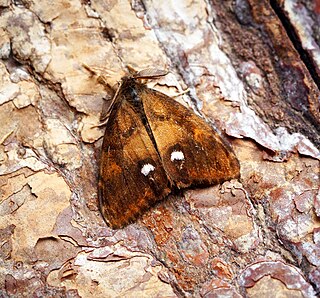
Orgyia antiqua, the rusty tussock moth or vapourer, is a moth in the family Erebidae.
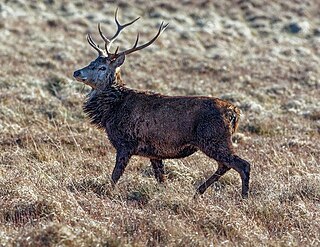
The fauna of Scotland is generally typical of the northwest European part of the Palearctic realm, although several of the country's larger mammals were hunted to extinction in historic times and human activity has also led to various species of wildlife being introduced. Scotland's diverse temperate environments support 62 species of wild mammals, including a population of wild cats, important numbers of grey and harbour seals and the most northerly colony of bottlenose dolphins in the world.

Illidge's ant-blue butterfly, is an endangered species of butterfly endemic to Australia. This species can be found at six confirmed sites: Mary River Heads, Beaver Rock and Maaroom in the Fraser Coast Region (Queensland); Redland Bay and Point Halloran in the City of Redland (Queensland), and Brunswick Heads.
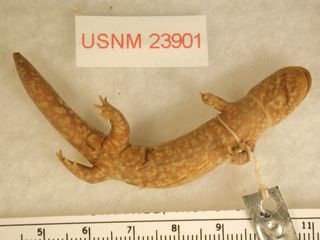
The amber salamander, amber-colored salamander, tortoiseshell salamander, or Stejneger's oriental salamander is a species of salamander in the family Hynobiidae, endemic to Japan. Its natural habitats are temperate forests and rivers. It is threatened by habitat loss.

The northern two-lined salamander is a species of salamander in the family Plethodontidae found in Canada and the United States. Its natural habitats are temperate forests, temperate shrubland, rivers, intermittent rivers, freshwater marshes, freshwater springs, arable land, and urban areas. It is more water-oriented than the related northern redback salamander, and can often be found in and around water such as rain puddles, streams, swamps, and damp stream beds, whereas the northern redback tends to be found in damp ground, but usually not near open water.

The gibberbird is a species of chat within the Meliphagidae family of passerine birds.

The white-faced darter or small whiteface is a dragonfly belonging to the genus Leucorrhinia in the family Libellulidae, characterised by red and black markings and a distinctive white patch on the head. It is found in wetlands and peat bogs from northern Europe eastwards to Siberia, and the adults are active from around April till September, which is known as the "flight period". It breeds in acidic bodies of water, laying its eggs in clumps of sphagnum moss that provide a safe habitat for larval development. The larvae are particularly vulnerable to predation by fish, and so are usually found in lakes where fish are not present. L. dubia is listed as a species of least concern (LC) by the IUCN Red List, however, it is potentially threatened by habitat destruction, pollution, and climate change.

Abantiades latipennis, known as the Pindi moth, is a species of moth in the family Hepialidae. It may also be referred to as a swift moth or a ghost moth, as this is a common name associated with Hepialidae. Endemic to Australia and identified in 1932, it is most populous in temperate rainforest where eucalypti are prevalent, as the larvae feed primarily on the roots of these trees. Females lay eggs during flight in a scattering fashion. The larvae live for over eighteen months underground, while adult moths survive for approximately one week, as they have no mouthparts with which to feed. The moths are preyed upon by a number of predators, including bats and owls. Brown in colour overall, males are paler and the identifying silver bars of the male's wings are more prominent than those of the female's, with dark margins. Male adults are generally smaller.
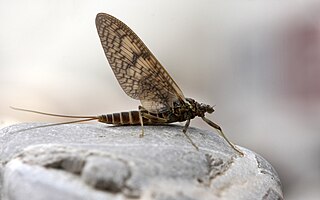
Rhithrogena germanica is a European species of mayfly, and is "probably the most famous of all British mayflies", because of its use in fly fishing. It is known in the British Isles as the March brown mayfly, a name which is used in the United States for a different species, Rhithrogena morrisoni. It emerges as a subimago at the end of winter, and can be distinguished from similar species by a dark spot on the femur of each leg.
The cypress darter is a species of freshwater ray-finned fish, a darter from the subfamily Etheostomatinae, part of the family Percidae, which also contains the perches, ruffes and pikeperches. It is endemic to fresh waters of the central and eastern United States. Its range includes drainages from the Choctawhatchee River, Florida, to the San Jacinto River, Texas, as well as the Mississippi River basin from southern Illinois and eastern Oklahoma to the Gulf of Mexico. It inhabits vegetated margins of swamps and lakes, and backwater habitats during the summer, while in winter it moves to flooded riffles and backwater bayous. It feeds mostly on small crustaceans, as well as insects and their larvae. Spawning takes place during spring and summer, with clusters of up to three eggs being laid, often stuck to the surface of dead leaves. The cypress darter has a very wide range and its population trend seems to be stable. It is a common species with numerous sub-populations, and the International Union for Conservation of Nature has assessed its conservation status as being of "least concern".
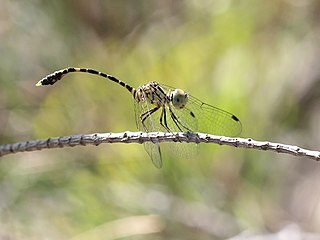
Nannophlebia risi, known as the common archtail, is a species of dragonfly in the family Libellulidae. It is endemic to Australia.

Antipodogomphus dentosus is a species of dragonfly of the family Gomphidae, commonly known as the Top End dragon. It is endemic to Northern Territory, Australia, where it has been found in rivers.

Stenoperla prasina is a species of stonefly belonging to the family Eustheniidae. This species is endemic to New Zealand and is classified as "Not Threatened" under the New Zealand Threat Classification System. It is found on the North, South and Stewart Island / Rakiura Islands as well as on Little Barrier Island. Although adults of this species are most often coloured bright green, this species can be coloured yellow. This species inhabits clean, cold, running streams and rivers with stony bottoms within native bush. It is a known indicator of water quality. The larvae eat plant detritus and other aquatic insects while the adult insects feed on sooty mould fungi as well as other plant matter. The adults of this species are a known food source for New Zealand long tailed bats. Adults have been dissected and have been found to have been carrying Nematomorpha and trematode parasites. The New Zealand Department of Conservation classifies this species as "Not Threatened". In 2022 a specimen of this species was the 5 millionth specimen to be digitised in the Natural History Museum, London collection.
Perlodes mortoni, the orange-striped stonefly, is a species of stonefly that is found in Great Britain.

















